Maglev Wind Turbine and Solar Panel for Streetlight
Abstract: This work describes the implementation of VAWT and solar panel for electricity generation from renewable energy sources that are wind energy and solar energy respectively. The VAWT worked on electromagnetism principle has suspension system of permanent magnets instead of ball bearing used in conventional wind turbines. The electrical energy generated by this hybrid system is then used for streetlight purpose.
Keywords: Wind energy, Solar energy, Magnetic Levitation, VAWT, Savonius Turbine, Solar panel
1. INTRODUCTION
         The primary factor for survival of human beings is the energy. Everything what happens in the world is the expression of flow of energy from one form to another. Electric power is not available in many rural areas due to high cost of generation and distribution to small dispersed users. For electricity generation we have to greatly depend upon hydraulic and nuclear power plants. But due to their certain disadvantages like area compensation, high initial cost, availability of resources and also the pollution, there is need to rethink on some another renewable energy resources. Solar energy and wind energy are available abundantly all over the world with free of cost. These energies are harnessed by human beings for a long time and with the advanced technologies we can take their advantage to generate electricity.
          The potential of solar energy is 178 billion MW which is about 20000 times the world’s demand and the potential of wind energy is 1.6Ã-107 MW equal to magnitude of present energy consumption on the earth. The solar energy can be converted to electrical energy by photovoltaic cells. The kinetic energy of wind can be converted to electrical energy by wind turbine. As conventional wind turbine has certain disadvantages; vertical axis wind turbines (VAWT) are the alternate solution. The merits of VAWT are low initial and running cost, easy installation, less space acquired, capability to capture wind from any direction and elimination of ball bearings by the use of magnetic levitation technique. The advantage of these two renewable energy resources can be taken by making a hybrid system so we do not required depending on availability of any single resource. The electricity required for domestic purpose can be generated by unique combination of solar system and wind system.
2. LITERATURE REVIEW
2.1 Solar power
        The solar power where sun hits atmosphere is 1017 watts, whereas the solar power on earth’s surface is 1016 watts. The total world-wide power demand of all needs of civilization is 1013 watts. Therefore, the sun gives us 1000 times more power than we need. If we can use 5% of this energy, it will be 50 times what the world will require.
2.2 Principle of working of photovoltaic cell
         Electricity can be produced from the solar energy by photovoltaic solar cells. When photons from the sun are absorbed in a semi-conductor, they create free electrons with higher energies than the electrons which provide the bonding in the base crystal. Once these free electrons are created, there must be an electric field to induce these higher energy electrons to flow out of the semi-conductor to do useful work. The electric field in most solar cells is provided by a junction of materials which have different electrical properties. The photovoltaic effect can be easily described easily for p-n junction in semi-conductor materials of solar cells which are silicon, cadmium, sulphide/copper sulphide , gallium arsenite.
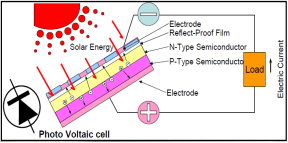
Fig-1 Working principle of photovoltaic cell
2.3 Various type of solar cell
Thecomparison of various types of pv-cell is
|
Price |
Efficiency |
1 W size |
Current production |
|
|
Single crystal |
High |
10-17% |
1 |
About 30% |
|
Polcrystalline |
Medium |
10-13% |
1.3 |
About 60% |
|
Amorphous |
Low |
7-10% |
1.7 |
About 10% |
2.4 Wind energy
Wind energy is an indirect source of solar energy. Factors responsible for wind are-
1. Heating and cooling of the atmosphere which generates convection  currents. Heating is caused by the absorption of solar energy on the earth’s surface and in the atmosphere.
2. The rotation of earth with respect to atmosphere, and its motion around the sun.
2.5 Wind power
Three factors determine the output from wind energy converter-
1. The wind speed
2. The cross section of wind swept by rotor, and
3. The overall conversion efficiency of rotor, transmission system and generator or pump.
         No device, however well designed, can extract all of the winds energy because the wind would have to be brought to a halt and this would prevent the passage of more air through the rotor. The most that is possible is for the rotor to decelerate the whole horizontal column of intercepted air to about one-third of its free velocity. A 100% efficient aerogenerator would therefore only be able to convert upto a maximum of around 60% of the available energy in wind into mechanical energy. Well-designed blades will typically extract 70% of the theoretical maximum, but losses incurred in the gear box, transmission system and generator or pump could decrease overall wind turbine efficiency to 35% or less.
         The wind mill works on the principle of converting kinetic energy of wind to mechanical energy.
The mass of wind is-
                          ………….. (1)
            ………….. (1)
Kinetic energy of wind is-

 Watts       …………… (2)
Watts       …………… (2)
But, the power is nothing but kinetic energy of wind. Hence, available wind power-
     Watts
Watts
         Watts  ……….. (3)
Watts  ……….. (3)
Where,
         A= area swept by the blades, m2
         V= velocity of wind, m/s
         ê¬= air density (1.225 kg/m3 at sea level)
2.5 Types of VAWT
1. Savonius rotor
Characteristics of Savonius rotor
- Self-starting
- Low speed
- Low efficiency.
Advantages:
- The machine performs at low wind velocity ranges.
- It has simple construction, hence easy to manufacture.
- Cost of VAWT may be significantly lower than that of standard wind turbine.
- Ground level mounting.
- Overall weight of the turbine may be substantially less than of conventional system.
Disadvantages:
- This type of machine is too solid, having so much metal
- It is not useful for a very tall installation because a long drive shaft problems.
2. Darrieus rotor
Characteristics of Darrieus rotor
- Not self-starting
- High speed
- High efficiency
- Potentially low capital cost
Advantages:
- Rotor blades can accept the wind from any direction
- Ground level mounting
- Eliminate yaw control mechanism
- Less airfoil fabrication cost
Disadvantages:
- It requires external mechanical source for start up
- At low height, it experiences a lower wind velocity compare to conventional turbines
3. MAGNETIC LEVITATION
3.1 Principle
As we know that, when two like poles of magnet are bring together, they get repels from each other. This characteristic of magnet is used for the suspension purpose in vertical axis wind turbine. Due to the absence of physical contact between magnetic bearings, there is benefit of no friction and hence no wear. Also the no need of lubrication, no power loss and the absence of noise generation.
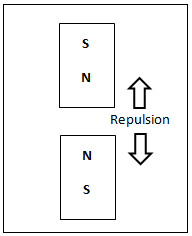
Fig-2 Principle of Magnetic Levitation
3.2 Magnet Selection
The strength of magnet to get attract or repels is depend on its material configuration. There are basically four categories of magnet that are alnico, ceramic, samarium cobalt and neodymium iron boron (Nd-Fe-B). Nd-Fe-B is the newest invention out of these which exhibits strongest magnetic properties. This magnet is used for the suspension purpose in VAWT. The repelling force exerted by these magnets holds the weight as well as force exerted by wind turbine.
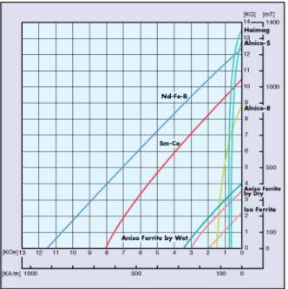
Fig-3 B-H curve of different magnets [1]
         From figure B-H curve depicts attractive magnetic characteristics of Nd-Fe-B offering high flux density with the ability of resisting the property of demagnetization.
         The permanent magnets selected were N-42 grade Nd-fe-B having ring shape which consist of nickel plating for strengthening and protecting the magnet.
3.3 Magnet placement
To obtain thenecessary suspension for wind turbine, two ring shaped Nd-Fe-B magnets are arranged at the middle of the shaft. Magnetic suspension leads to frictionless, noiseless, maintenance less and power loss less rotations of rotor over stator. The similar 8 number of Nd-Fe-B disc shaped magnets are located around the bottom side periphery of wooden disc at above the top magnet. The flux generated by these disc shaped magnets is used for power generation with the help of the generator.
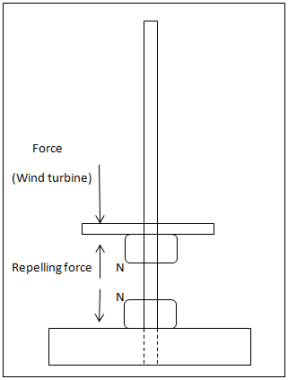
Fig-4 Placement of ring magnet on turbine shaft
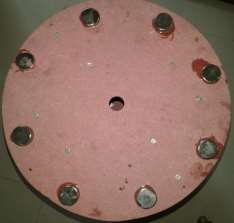
Fig-5 Placement of disc magnets on rotor
4. COIL DESIGN AND IT’S ARRANGEMENT
To design the definite number of turns per coil is difficult. If the more turns are wound it increase the emf generated from each coil but increase the size of the every coil. For minimizing the size, wire having higher gauge can be used. If the diameter of wire is small low amount of current will flow leading to heating ofwire because of the increased resistance of wire which is another difficult task.
        Field density is the problem attached with large size coil for designing the generator for given application. Increase in gap between two magnets by increasing height of coil results in reduction of magnetic flux. Hence necessary voltage and current must be balanced.

Fig-7 Coil arrangement on stator
5 HYBRID SYSTEM
Sometimes due to unavailability of any single resource that is either solar energy or wind energy, there is effect on efficiency of such system. Also to decrease the load on single system, we can interconnect the solar system and wind system together. The output of solar system is DC and that of wind system is AC. So by the use of rectifier AC can be converted to DC and finally this combined DC is given to battery for storage purpose.
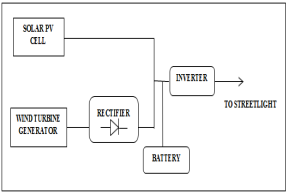 Â Â Â Â Â Â Â Â Â Â Â Â Â Â Â Â Â Â Â Â Â Â Â Â Â Fig-8 Hybrid system
                         Fig-8 Hybrid system
6. ENERGY STORAGE
When there is no need of generated electrical energy or when the generated energy is excess than demand for application, there is need to store electrical energy. Therefore a 12V battery is used for storage purpose. The electrical energy is stored in the battery in the form of chemical energy when not to used and get convert from chemical energy to electrical energy
When required to be used.
7. CONCLUSION
The efficiency and effectiveness of VAWT increases due to the use of magnetic levitation principle. For domestic application it is convenient to use Maglev turbine than to use conventional turbine as it requires less space and also low initial and maintenance cost.
         Maglev turbine with large capacity gives more power than conventional horizontal axis turbine. To decrease the load on any single system, the concept of interconnection of solar and wind is very helpful. This hybrid system along with streetlight application can be used for several domestic applications like mobile and laptop charging, CCTV, to enlighten the single room etc. Use of renewable energy sources with initial investment can make the user free from electricity bill.
8. REFERENCES
[1] Harshal V. and Kharat R. K, “Power generation using Maglev Windmill” International Journal of Research in Engineering and Technology (IJRET) Volume: 05 Issue: 06 June: 2016
[2] Ashvin P. Joseph “Review paper on Wind Turbine using Magnetic Levitation” International Journal of Research in Engineering and Technology (IJRMET) Volume: 6 Issue:1 Nov 2015-April 2016
[3] G. D. Rai, “Non-conventional energy sources” Khanna publishers, fourth edition, 2008
[4] B. Bittumon “Design and analysis of Maglev Vertical Axis Wind Turbine” International journal of emerging technology and advanced engineering (IJETAE) Volume: 4 Issue: 4 April 2014
Order Now